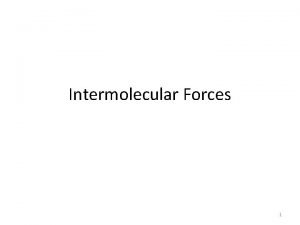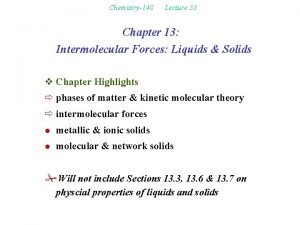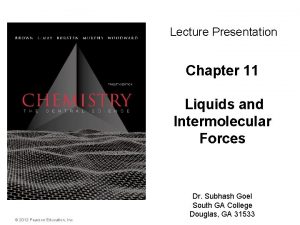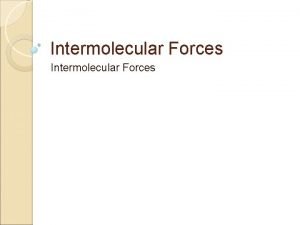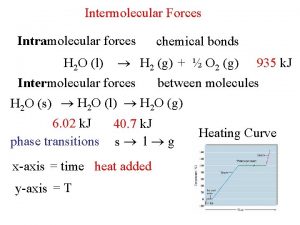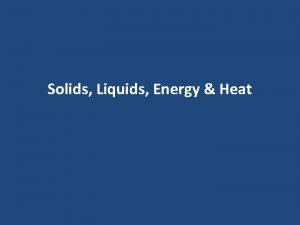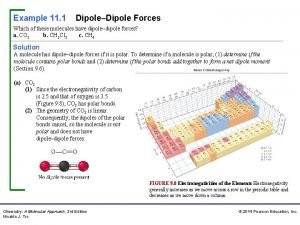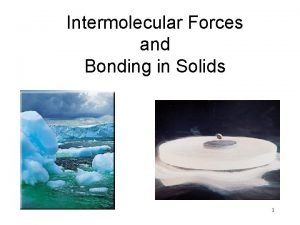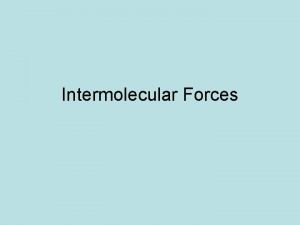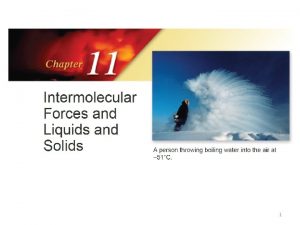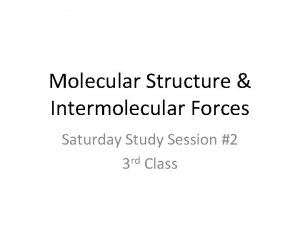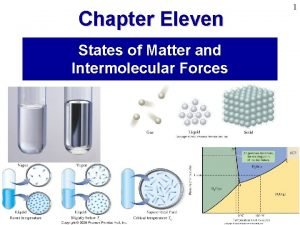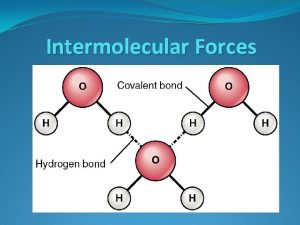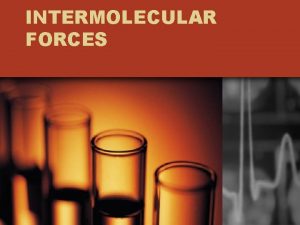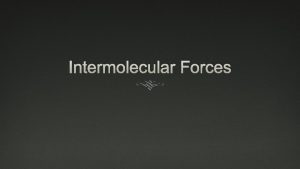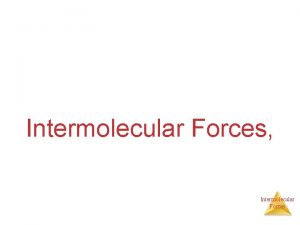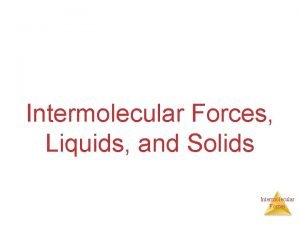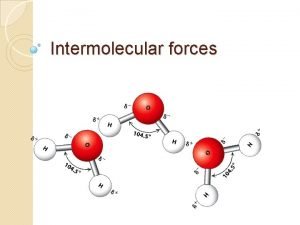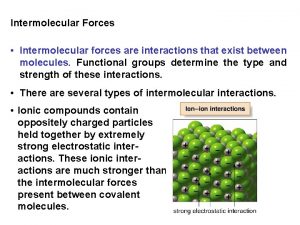Intermolecular Forces 11 2 Intermolecular Forces The forces
















- Slides: 16

Intermolecular Forces 11. 2

Intermolecular Forces �The forces of attraction that exist outside the molecule itself, and that hold many molecules together in order to form a solid, liquid are called intermolecular forces.

Covalent vs. Ionic �Covalent molecules are held together by intermolecular forces. �While Ionic compounds are held together by ionic bonds that form a crystal lattice.

Intramolecular Forces �Intramolecular forces are the primary bonds that exist within the molecule itself. These are ionic, covalent, and metallic bonds.

Strength of Forces �Boiling and melting points are a measure of the strength of the forces holding the particles together.

Strength of Forces �The higher the melting points and boiling points of a substance, the stronger the forces. �The lower the melting and boiling points are of a substance, the weaker the forces.

Force determine state � Solids have strong intermolecular forces that hold the atoms in place. � Liquids have weaker intermolecular forces than solids and so the atoms are able to move and slide past each other. � Gasses have no intermolecular forces and so the molecules are completely independent and move freely apart from each other.

Strongest to weakest �The Intermolecular forces that exist are the following (listed from strongest to weakest): 1. Ionic, Metallic, Covalent 2. Dipole-Dipole a. Attraction between polar molecules b. Hydrogen Bonding c. London Dispersion

Ionic, Metallic, Covalent are the strongest �Ionic Compounds have ionic bonds holding the compound together. These are the strongest forces so they tend to be solids with high melting and boiling points.

Covalent Molecules have weaker forces holding them together �Covalent Molecules have dipole or london dispersion forces holding them together: they are the weaker forces and so these molecules are either liquids or gasses and have lower melting and low boiling points. Exception: Network Solids, example: Diamonds

Dipole-Dipole �In Dipole-Dipole forces: the positive end of one molecule attracts the negative end of a neighboring molecule. �Dipole-Dipole forces operate in polar molecules.

Hydrogen Bonding �Hydrogen bonding is a strong dipole-dipole force that only exists between Hydrogen and Nitrogen, Oxygen, or Flourine. �Example: Water

London Dispersion Forces �London dispersion forces exist in non-polar molecules. This occurs when the molecules become momentarily polar and the opposite charges attract. Since these are the weakest forces, gasses result.

From state at Room Temperature, Predict type of Intermolecular Force � Substance given ◦ 1. State at room temperature ◦ 2. Melting point and boiling point? Choose high, low, or medium �Hint – If it is a gas at room temperature, it has low melting and boiling points, if it is a liquid, it has medium melting and boiling points, if it is a solid, it has high melting and boiling points. � Exception – Liquids with hydrogen bonding

Type of Intermolecular Force � Or type of bond (this means molecule to molecule) ◦ 3. If it is an ionic compound, type of bond is ionic. ◦ 4. If covalent, pick dipole-dipole or hydrogen bonding if polar, or london dispersion if nonpolar ◦ 5. If it is a metal, pick metallic bonding. ◦ Exception – Diamond is a network solid so it is covalent throughout all of the atoms.

Polar or Nonpolar? � 1. Big electronegativity difference means it is polar. The most electronegative elements are the halogens. � 2. Small electronegativity difference means it is nonpolar. ◦ Example: Same atoms bonded, Carbons to hydrogens bonded, atoms with almost the same electronegativity bonded.
 Intramolecular forces vs intermolecular forces
Intramolecular forces vs intermolecular forces Intermolecular forces from strongest to weakest
Intermolecular forces from strongest to weakest Difference between intermolecular and intramolecular
Difference between intermolecular and intramolecular Similarities of intermolecular and intramolecular forces
Similarities of intermolecular and intramolecular forces Intermolecular forces
Intermolecular forces Intermolecular forces
Intermolecular forces Intramolecular vs intermolecular forces
Intramolecular vs intermolecular forces Surface tension intermolecular forces
Surface tension intermolecular forces Dipole-dipole interaction example
Dipole-dipole interaction example Hcn bonding pairs
Hcn bonding pairs 3 types of intermolecular forces
3 types of intermolecular forces Ch2cl intermolecular forces
Ch2cl intermolecular forces Solid
Solid Van der waals gecko
Van der waals gecko Surface tension intermolecular forces
Surface tension intermolecular forces No structure
No structure Is matter
Is matter



